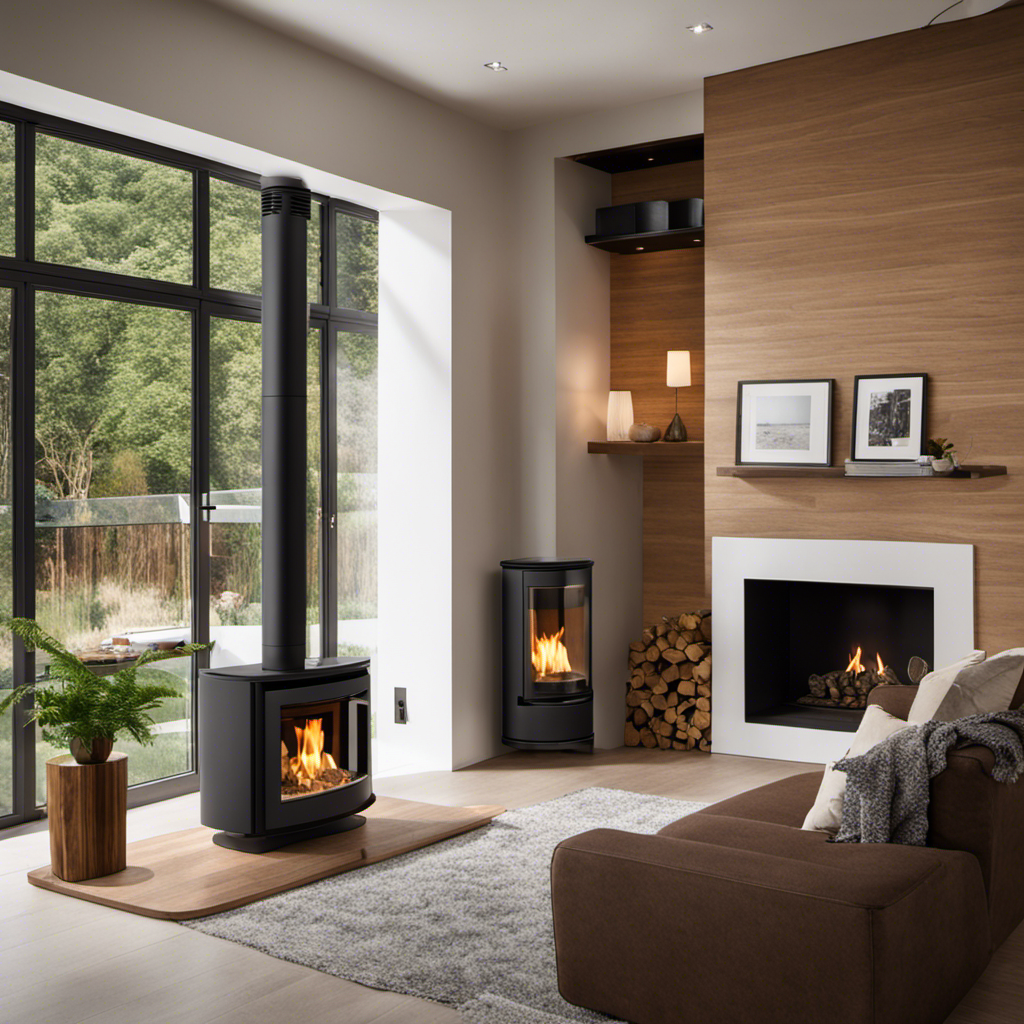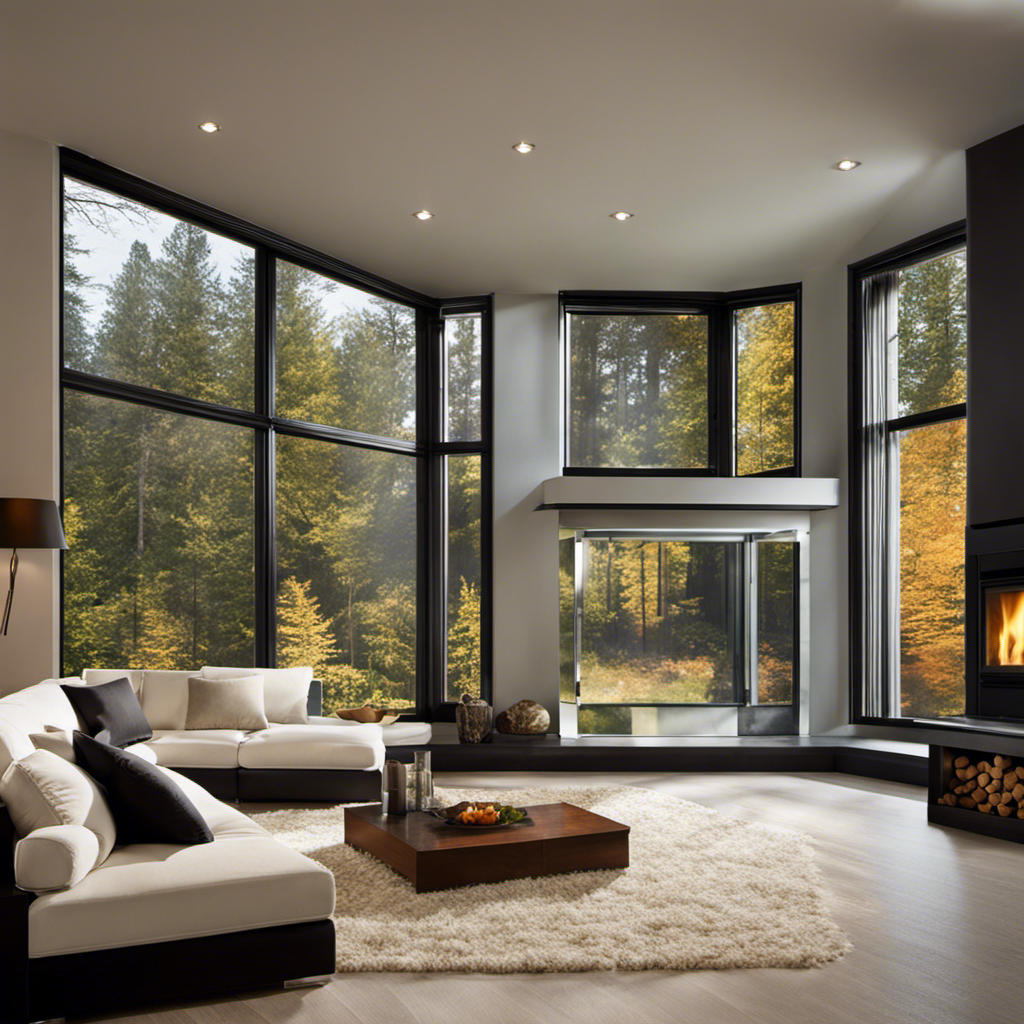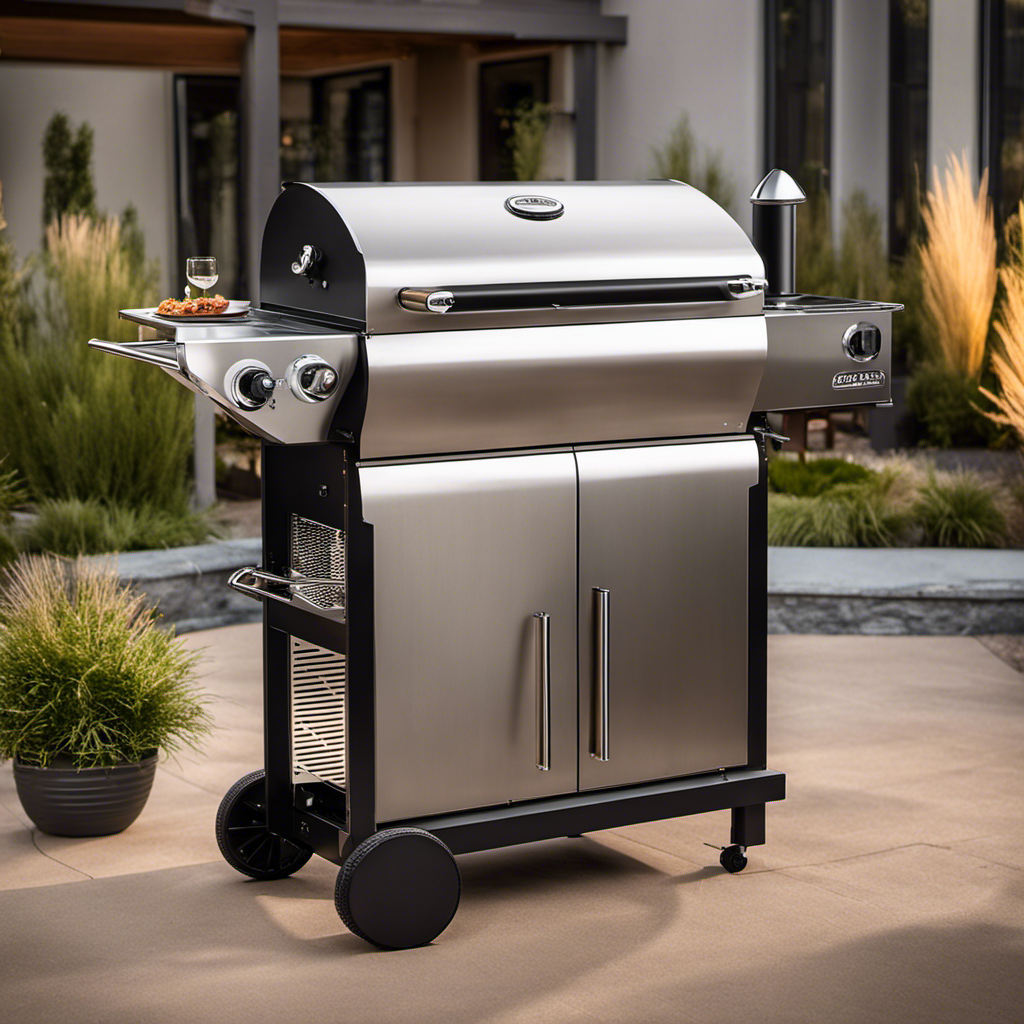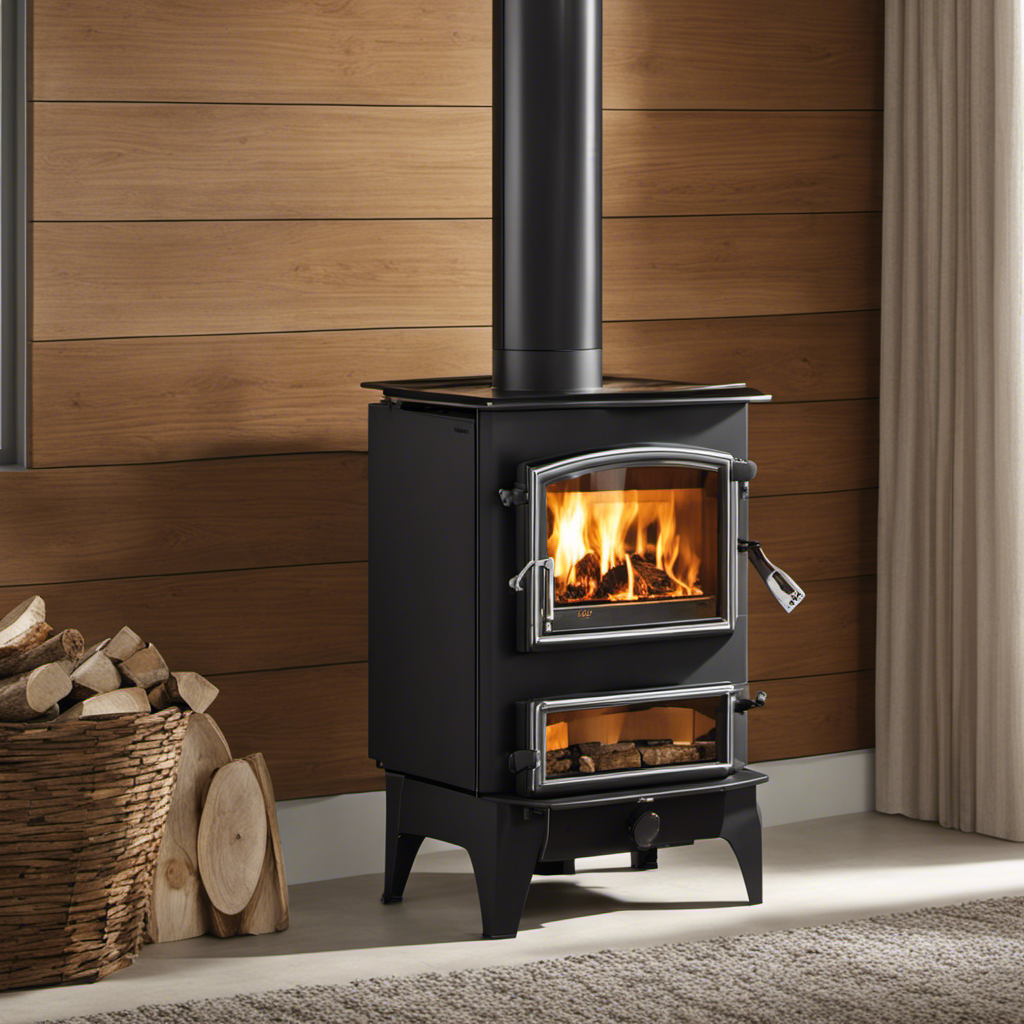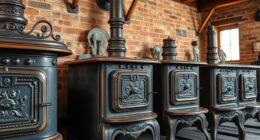Fed up with the expensive heating bills and their impact on the environment? We’ve discovered an answer that’s kind to both nature and your finances: pellet stoves.
These innovative heating devices burn wood pellets, providing efficient and clean-burning heat for your home.
Not only are pellet stoves cost-effective in the long run, but they also reduce waste and reliance on non-renewable energy sources.
Join us as we explore the ins and outs of pellet stoves, including how they work, cost comparisons, environmental benefits, and factors to consider before making a purchase.
Key Takeaways
- Pellet stoves burn wood pellets made from compressed sawdust and wood waste materials.
- Pellet stoves are efficient, clean-burning, and can be controlled with a thermostat.
- Wood pellets are made from renewable wood waste materials, reducing waste and the demand for non-renewable energy sources.
- Factors such as space size, pellet availability, and maintenance costs should be considered before purchasing a pellet stove.
How Pellet Stoves Work
We learned that pellet stoves burn wood pellets made from compressed sawdust and wood waste materials. These stoves offer several advantages that make them a great heating solution for homes.
One advantage is their cost-effectiveness. While the initial cost of a pellet stove may be higher compared to traditional stoves, the ongoing cost of wood pellets is lower.
Additionally, pellet stoves are environmentally friendly. They use renewable wood waste materials, reducing waste and the demand for non-renewable energy sources.
The installation process for pellet stoves is relatively simple. A professional will install the stove and connect it to a venting system. Once installed, you can control the stove’s temperature with a thermostat, ensuring optimal comfort.
Overall, pellet stoves provide an efficient and eco-friendly heating option for homeowners.
Cost Comparison
When comparing costs, it’s important to consider the initial price, ongoing maintenance, and the price of wood pellets in your area. Here’s why pellet stoves are a cost-effective choice compared to electric heaters and traditional heating methods:
- Pellet stoves provide long-term savings on heating bills due to their high efficiency and ability to heat larger spaces.
- Wood pellets are a renewable and affordable fuel source, making them more cost-effective than electricity or fossil fuels.
- Government incentives and energy rebates can significantly reduce the initial purchase price of a pellet stove, making it an even more economical choice.
By choosing a pellet stove over electric heaters or traditional heating methods, you not only save money but also contribute to a cleaner and more sustainable environment.
Environmental Benefits
Using wood pellets as a fuel source offers numerous environmental benefits, such as reducing waste and the demand for non-renewable energy sources. Pellet stoves, which utilize wood pellets, are an excellent choice for those looking to decrease their carbon footprint while still enjoying a warm and cozy home. Not only are wood pellets made from renewable materials, but they also produce fewer emissions compared to traditional wood-burning stoves. This has a positive impact on air quality and reduces the release of harmful pollutants into the atmosphere. By choosing a renewable energy source like wood pellets, we can contribute to a cleaner and healthier environment for ourselves and future generations.
| Environmental Benefits of Wood Pellet Stoves |
|---|
| Renewable energy sources |
| Decrease in waste |
| Positive impact on air quality |
Factors to Consider Before Purchasing a Pellet Stove
Before making a decision, it’s important to carefully consider factors such as the size of the space to be heated, availability and cost of wood pellets in your area, and ongoing maintenance costs of a pellet stove.
When evaluating the space requirements, think about the size of the room or area you want to heat. A pellet stove may be more suitable for smaller spaces, while larger areas may require multiple stoves or alternative heating options.
Maintenance considerations are also crucial. Pellet stoves require regular cleaning to ensure optimal performance and efficiency. This includes emptying the ash pan, cleaning the burn pot, and inspecting and cleaning the venting system. It’s important to factor in the time and effort required for maintenance, as well as any additional costs for professional servicing if needed.
Taking these factors into account will help you make an informed decision about whether a pellet stove is the right heating solution for your needs.
In Conclusion
Overall, we found that pellet stoves offer a cost-effective and environmentally-friendly option for heating our home. When comparing pellet stoves to traditional wood-burning stoves, there are several pros and cons to consider.
One major advantage of pellet stoves is their efficiency. They burn wood pellets made from compressed sawdust and wood waste, which results in a higher heat output compared to traditional wood stoves. Additionally, pellet stoves can be controlled with a thermostat, allowing for precise temperature regulation and increased comfort.
However, there are a few drawbacks to consider. Pellet stoves require electricity to operate, which means they won’t work during power outages. They also require regular maintenance, such as cleaning the burn pot and chimney, to ensure optimal performance.
In comparison to traditional wood stoves, pellet stoves offer cleaner and more eco-friendly heating. They produce fewer emissions and use renewable wood waste materials. While the initial cost of a pellet stove may be higher, the ongoing cost of wood pellets is generally lower than purchasing firewood.
In conclusion, pellet stoves provide a viable heating solution that’s both cost-effective and environmentally-friendly. They offer higher efficiency, cleaner burning, and the ability to control temperature. While there are some drawbacks to consider, the benefits outweigh the cons.
When making a decision, it’s important to consider the size of the space, availability of wood pellets, ongoing maintenance costs, and overall practicality. With government incentives and rebates available, pellet stoves can be a smart investment for heating your home.
Frequently Asked Questions
Are Pellet Stoves Suitable for All Types of Homes or Are There Specific Requirements?
Pellet stoves have pros and cons when it comes to different types of homes. They can be suitable for many homes, but there are specific requirements to consider. Factors such as space size, pellet availability, and ongoing maintenance costs should be taken into account.
It’s important to compare pellet stoves to other heating options to determine what’s best for your home. Overall, pellet stoves offer an affordable and eco-friendly heating solution, but careful consideration is necessary before making a decision.
How Long Does a Bag of Wood Pellets Typically Last and How Often Do They Need to Be Refilled?
A bag of wood pellets typically lasts for several hours, depending on the size and heating needs of your home. The frequency of refilling will also vary based on factors such as the temperature setting and insulation of your space.
However, on average, you can expect to refill the pellet stove every 12 to 24 hours. This makes it a convenient and efficient heating solution, allowing you to enjoy warmth without constantly monitoring the stove or refilling it frequently.
Can Pellet Stoves Be Used as the Primary Source of Heating or Are They More Suitable as Supplemental Heat?
Using pellet stoves as the primary heat source vs. supplemental heat depends on various factors. While pellet stoves can effectively heat a home, their suitability as the primary heat source may vary depending on the size of the space, insulation, and climate.
However, pellet stoves are a great supplemental heat option, providing cost-effective and eco-friendly warmth. They have a lower environmental impact due to their clean-burning nature and use of renewable wood waste materials.
Consider your specific needs and factors before deciding on using pellet stoves as the primary heat source.
Do Pellet Stoves Require Any Specific Ventilation or Chimney Requirements?
Pellet stoves do require specific ventilation and chimney requirements. Proper ventilation is crucial to ensure the safe and efficient operation of the stove. A vent pipe is connected to the stove, which directs the exhaust gases outside. The vent pipe must be installed correctly and meet local building codes.
Additionally, pellet stoves need a functioning chimney or flue system to provide proper airflow and remove combustion byproducts. It’s essential to consult a professional to ensure the ventilation and chimney requirements are met for your specific pellet stove installation.
Are There Any Safety Concerns or Precautions That Need to Be Taken When Using a Pellet Stove?
Safety concerns and precautions are important when using a pellet stove. It’s crucial to keep flammable materials away from the stove and to ensure proper ventilation to prevent carbon monoxide buildup.
Regular cleaning and maintenance of the stove, including the chimney and exhaust pipe, are necessary to reduce the risk of fire.
Additionally, it’s essential to follow the manufacturer’s instructions for safe operation and to install smoke and carbon monoxide detectors for added safety.
Conclusion
In conclusion, pellet stoves are the ultimate heating solution that will revolutionize your home. With their cost-effective and eco-friendly nature, they’ll blow your mind and warm your space like never before.
Say goodbye to high heating bills and harmful emissions, and say hello to a cozy and sustainable future.
Don’t miss out on this incredible opportunity to save money, help the environment, and enjoy the comfort you deserve. Get your pellet stove today and experience the extraordinary benefits for yourself.
Logan’s affair with adventure began in childhood. He hailed from a small town where vast forests bordered one side and endless shores stretched on the other. His days were spent exploring uncharted woods, climbing tall trees, or listening to the tales of old sailors. This early immersion in a world brimming with stories and mysteries became the foundation of his passion for writing.

